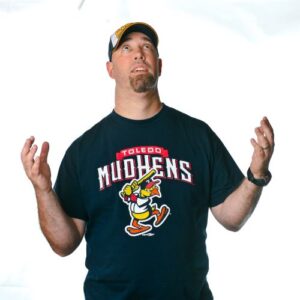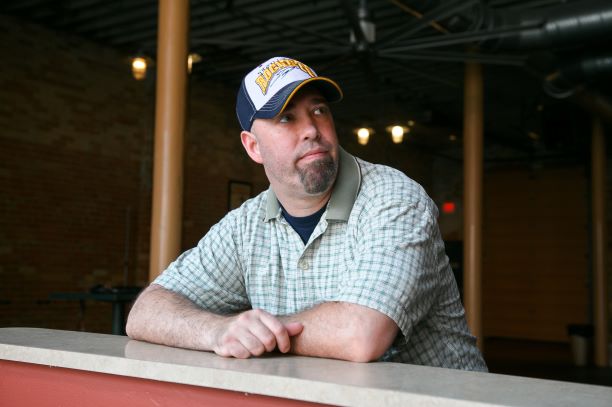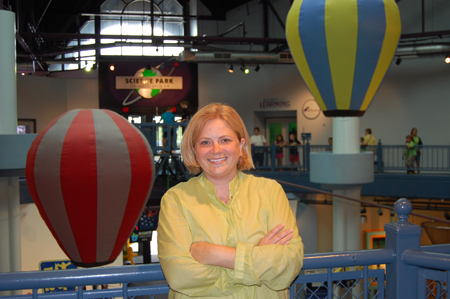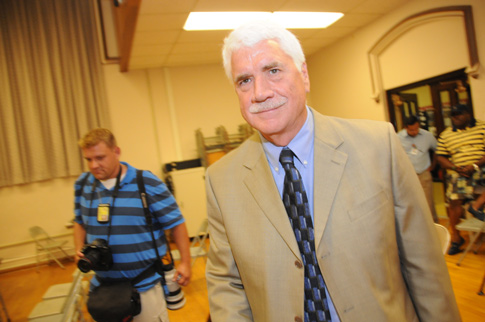Don Zellers considers himself the typical Toledo taxpayer.
At 41, Zellers is married and, for the first time in his life, the owner of a house, which he and his wife purchased five years ago. In October, Zellers, who has lived in the Toledo area all his life, lost his job with Clear Channel Toledo after surviving a few rounds of cutbacks.
Zellers works part-time positions with Clear Channel and Great Lakes Trivia, and began freelance writing for local publications, including restaurant reviews for Star, after being out of work for a month and a half.
He said he feels frustrated and overwhelmed with the seven levies Lucas County voters will face Nov. 6: five county levies, the Toledo Public Schools (TPS) 6.9-mill continuing levy for those in the TPS district and the 1-mill Parks and Recreation levy for Toledo citizens.
“A lot of people, including myself, are not getting raises and are making less money than they did last year, but the city expects us to pay more,” Zellers said. “And if you’re already making less money, where is that money supposed to come from? … It’s not like I’m living in abject poverty, but I’m definitely not living on the high horse.”
As an on-air personality with Fred LeFebvre on the 1370 AM WSPD morning show, Zellers has become the face of a station campaign to address the “levy fatigue” and its effect on the wallets of county taxpayers.
“What about Don?” is the question LeFebvre asks his listeners to consider when they head to the polls this November.
“We want people to begin to think of Don and themselves when they go to vote,” LeFebvre said. “It’s an individual choice, not a group or city choice.
“Think — do you want to raise your taxes? Can you afford it?”
Toledo-Lucas County Public Library
The Toledo-Lucas County Public Library is placing a 2.9-mill levy on the ballot that if passed will replace and increase their 2-mill levy, which is due to expire at the end of this year. The current 2-mill levy has been in effect for four years. The proposed levy will not require renewal for five years.
The levy will cost the owner of a $100,000 home $88.80 per year for five years, according to a newsletter on the Toledo Regional Chamber of Commerce’s website, toledochamber.com. This is a $27.55 per-year increase from the $61.25 taxpayers owning $100,000 homes have paid each year since 2007.
Rhonda Sewell, library media relations coordinator, said this levy is expected to generate $21 million to $23 million per year, which she said accounts for about half of the library’s budget. The other half is provided by the State of Ohio Public Library Fund (PLF).
A library operating levy has not been defeated since 1977. Sewell said a capital levy failed in 1991 but when reintroduced in 1995, it passed with 74 percent of the vote.
Clyde Scoles, executive director of the Toledo-Lucas County Public Library, said the 1995 capital levy was one of the largest bond issues passed
in Lucas County at the time. It upgraded, expanded and modernized the library system, Scoles said.
In 2009, 17.8 percent of the library’s state aid was cut. Since then, about 27 percent of library hours have been cut. The Sanger branch on West Central Avenue is the only library left with Sunday hours. Sewell said the library is operating at 1996 levels of funding from the state.
While Sewell said the library cannot promise all previously cut hours will be restored, the levy is expected to return the hours, staff members and materials lost in the cuts. Scoles said 50 percent of the current hours may have to be cut if this levy does not pass.
Scoles said he is hoping the increased levy generates $5 million to $6 million more per year for the library system that recorded nearly 3 million visits in 2011. Scoles and Sewell cite the variety of services the branch provided by the 19 neighborhood branches, where attendance has remained high during tough economic times, as reasons voters should support the library levy.
“We’re not talking so much about helping the library system but saving the library system,” Scoles said. “… People come for a variety of reasons — job information, homework help. Businessmen come in and grow their businesses using our databases and the expertise of business librarians and information centers. All of that would be curtailed quite a bit if our budget was cut by 50 percent.
Metroparks of Toledo Area
Metroparks of Toledo Area plans to become the most recent addition to the ballot for Lucas County voters, as the board of directors decided July 25 to place a 0.9-mill levy before voters in November.
The 0.9-mill levy would replace the 0.3-mill levy that expires at the end of its ten-year term on Dec. 31. If passed, the 0.9-mill levy will require renewal in 10 years.
This levy provides the funds for the
Metropark system’s land acquisition, improvement projects and park operations, said Executive Director Steve Madewell.
The Metroparks’ 1.4-mill general operating levy, which is also a ten-year levy, is not set to expire for another five years.
According to the The Toledo Regional Chamber of Commerce, the owner of a $100,000 home would pay $27.56 per year, an increase of $19.10 from the $8.46 citizens pay to the current levy.
The last time a Metroparks levy failed was in the early 1990s, said Scott Carpenter, director of public relations for Metroparks. It was presented to the county the following year and passed.
Because of the long-term nature of Metropark projects, this upcoming levy would help finish projects at various stages of planning including the Middlegrounds in Downtown, the Blue Creek Conservation Area in Whitehouse and the Fallen Timbers Battlefield in Maumee, Carpenter said.
It would also provide for purchasing new land and maintaining the current parks.
“In addition to the completion of those projects, it would go toward the replacement and maintenance of restrooms, picnic areas, shelters and things like that,” Madewell said. “What we’re really focused on is preserving natural areas of open space and keeping clean, safe, natural and free Metroparks across the county.”
Lucas County Children Services
Lucas County Children Services will be represented on November’s ballot with a 1.85-mill levy. This is a 0.85 increase from the current levy, which will expire its five-year term in December 2013.
If passed, collection on the 1.85-mill levy wouldn’t start until 2014 and would continue for five years. Julie Malkin, the agency’s public information officer, said the agency is placing the issue on the ballot this year to better plan their finances in the coming year.
The 1.85-mill levy would cost the owner of a $100,000 home $56.66 per year, an increase of $26.04 on the current $30.62 per year paid to the 1-mill levy, according to the Chamber of Commerce.
Last year, voters approved a 1.4-mill levy for Children Services that will require renewal at the end of its five-year term. Combined, the agency would receive 3.25-mills from the county’s citizens, a decrease from the 3.5-mills the agency collected in 2001.
“We decreased our levy millage because we felt like we didn’t need to collect that much from taxpayers. We want to have a sound financial standing so that we make sure the children in Lucas County are safe,” Malkin said.
Federal funding, which makes up the bulk of the remainder of the agency’s funding, has been cut over the years. Malkin said local levy dollars are matched by federal dollars, so if the levy does not pass, more federal funding will be cut.
“We’ve been able to maintain the staffing levels of people that actually go out and see kids,” Executive Director Dean Sparks said. “Internally we have done everything we can to become a leaner system.”
The agency will have to cut $800,000 out of its budget if the levy passes, Sparks said. If it doesn’t pass, $13 million to $14 million of the agency’s $43 million will have to be cut.
“If it doesn’t end up passing this time or next time, that’s going to affect direct services for kids, services we contract for,” Sparks said. “We spend $350,000 for substance abuse services. Child advocacy contracts would be in danger, mentoring and tutoring for children would be in danger, not to mention there would be a significant layoff of our staff.”
Imagination Station
Imagination Station will ask voters to renew its 0.17-mill levy, which is set to expire at the end of 2013. The new levy would not take effect until 2014 and would continue for five years.
Executive Director Lori Hauser said the levy would generate about $1.3 million of the organization’s $3.2 million revenue by costing owners of a $100,000 home $5.21 a year.
The other $1.9 million is earned money, which comes from gate admission, memberships, corporate sponsorships, development and donations.
Twenty-seven percent of the nonprofit science center’s public funds go to exhibit maintenance and rental, Hauser said.
The rest goes to general operations and science education.
“We aren’t here to replace schools, we are here to work with schools,” Hauser said. “We’re wanting to get [kids] excited about [science]. Those are the careers of the future and we want to educate our youth.”
Hauser said corporations have invested $1.5 million in exhibits since 2009, including “Eat it Up!” with ProMedica and “Grow U” with The Andersons.
Hauser said Imagination Station is going on the ballot this fall because in case the levy does fail, like it did in 2006 and 2007 when it was called COSI, the extra time before the levy expires will give the center the opportunity to talk to citizens of Lucas County and find out their concerns and suggestions.
Mental Health and Recovery Services
The Mental Health and Recovery Services Board of Lucas County has placed a 10-year, 1-mill levy on the ballot. The board’s last levy renewal was passed in 2008, so this levy would generate new money for the agency.
Executive Director Scott Sylak said the agency has not asked taxpayers for new money in 24 years.
This levy would cost $30.62 per year for the owner of a $100,000 home, according to the Chamber of Commerce. This is in addition to the levy dollars already being collected by the agency’s 2008 levy.
“Basically, over the last six years, including this fiscal year, we’ve lost nearly $7 million. We’ve had to utilize $3 million of our reserves. We’ve cut our services by about $3.9 million and used $3 million of cash to supplement those losses to make up that gap. The issue now is we no longer have the reserve to supplement (our funds). We have no choice but to ask for new, additional dollars,” Sylak said.
Sylak said the agency has cut board and administrative services by more than 25 percent and has worked with its provider networks to improve the efficiency of the system and implement outcome measures to determine how effective the services are. Non-management staff has received one small pay increase in the past five years while executive and management staff haven’t received any increase.
“We don’t plan on increasing the amount of administration with these dollars at this time. We will critically evaluate the services that are most important to reinvest in, including treatment, medicine, housing, crisis support services and the expansion of kids services,” Sylak said.
Sylak said the levy will get the agency close to the dollar amount it has lost during the past six years.
Division of Recreation
Toledo City Council approved a new 1-mill levy for this November’s ballot, which would require renewal in 10 years.
Toledo City Councilman Steve Steel said the levy is expected to generate about $3 million per year for parks and recreation maintenance and programming.
Owners of a $100,000 home would pay $30.62 per year if the levy passed, according to the Chamber of Commerce.
Steel said Toledo has never had a recreation levy but almost every other community in the area has, including Maumee, Oregon and Sylvania.
Recreation funding comes from the city’s general fund, and when cuts must be made, parks and recreation funding is at the top of the list, Steel said. If this levy is passed, he said, the general fund might be loosened up for other city endeavors.
A task force of community members created a report that suggested multiple recommendations for raising funds for the recreation division. Steel said in addition to a levy, recommendations included charging for parking and admission into city swimming pools.
Steel said the city already charges admission into its pools and parking at Walbridge Park. Steel said other options they could have chosen were increasing summer baseball recreational league fees and charging for parking at all park locations.
City Council also chose to use funds from the Athletic Commission to fund a master plan. The master plan will determine what is needed from the city parks system and implement decisions made by citizens.
“We need to look at what is needed overall for recreation. Where are the gaps and what can the city do to fill those gaps?” Steel said.
Councilman Mike Craig has asked the city administration to hold off on demolishing the pools that have been identified for demolition. Steel plans to join Craig’s effort until taxpayers have the chance to create a dedicated funding stream for city recreation by passing this November’s levy.
Toledo Public Schools
Toledo Public Schools (TPS) is asking taxpayers to approve a new 6.9-mill continuing levy, which according to the Chamber of Commerce will cost the owner of a $100,000 home $211.28 per year.
The district is under investigation by the Ohio Department of Education for attempting to erase low attendance records by retroactively withdrawing and re-enrolling frequently absent students. Pecko went public with the district’s actions last week.
The money from the levy would fund the district’s current transformation program and balance the budget beyond the 2012-13 school year. While the 2012-13 budget is currently balanced, a failed levy in November would mean drastic cuts the following year.
“Without additional funding at this time, the district will have to cut an excess of $15 million before the beginning of the 2013-14 school year,” TPS Superintendent Jerome Pecko said at a news conference in May.
“6.9-mill is not going to get us what we need but we think that the community can support it,” said Jim Gault, chief academic officer for TPS.
The school system has made staff cuts along with cutting middle school sports and ninth-grade sports, the gifted program in grades three through six, busing for high schools and altogether eliminating Libbey High School. TPS has since brought back some of the sports programs.
Pecko said that the proposed levy would allow the district to pursue a new district-wide discipline program, a unified student data program for parents and teachers, the gifted program for grades three through six and employee evaluations based on student performance.
School Board President Lisa Sobecki urged voters to consider what the levy provides.
“I’ve personally had to do this in my own life: looking at our home budget and putting values behind choices, and I would ask the citizens of Toledo to do that and put values behind those budgets and think of the students that we serve and look at what they’ll be doing some day. They might be your pharmacist, your lawyer … we need to have an opportunity for a solid foundation.”
In November 2010, TPS proposed Issue 5, a 7.8-mill levy which voters rejected. That levy, which would have generated roughly $21.6 million, was the second to fail in 2010 as TPS attempted to meet its $40 million deficit.
Issue 5 would have been the highest millage amount passed for TPS in the past four decades, and the first levy passed for TPS since 2001.
Umbrella levy
Lucas County Commissioner Pete Gerken has suggested discussing an “umbrella” levy, encompassing all health and human services issues. Gerken said a few members of the Chamber of Commerce and the Citizens’ Review Committee are interested in being the sounding board for such a discussion, which Gerken said will likely occur after the November election.
“I think everyone has some thoughts about the number of levies and the crossover of services like human resources, finances and ‘backroom operations’ the organizations all do separately,” Gerken said.
Gerken said Ohio’s Montgomery County does a health and human services umbrella levy, and Gerken wants to facilitate a discussion to see if that could possibly work in Lucas County. Gerken said he does not know about the success or failure Montgomery’s levy has had.
“Any discussion we have will be unique to Lucas County. Certainly the concept of doing things in a coordinated fashion makes sense to me,” Gerken said.
Gerken said he has no notion of how the funds from this levy would be distributed, but said collection by the auditor and distribution by the commissioners is one idea to discuss.
“We may find out it doesn’t work, but until we sit down and everyone puts down their pieces we won’t know,” Gerken said. “Eventually, there’s going to be winners and losers. With evaluations down 12 percent, there’s less resources and we owe it to everybody to start working together.”
Adding it up
If the seven levies are passed in November, the cost to taxpayers owning a $100,000 home would be $450.75, up $105.54 per year, according to the Chamber of Commerce.
Once property evaluations received feedback from the state at the end of October, citizens will be able to calculate the exact amount they will owe in property taxes on the Auditor’s Real Estate Information System, available online at co.lucas.oh.us.
“I know people need money and there’s some good causes out there,” Zellers said. “But I don’t know this time. I’m not sure. … I don’t know if I can vote for any of them. I’ll have to really look at them all and decide.”


























